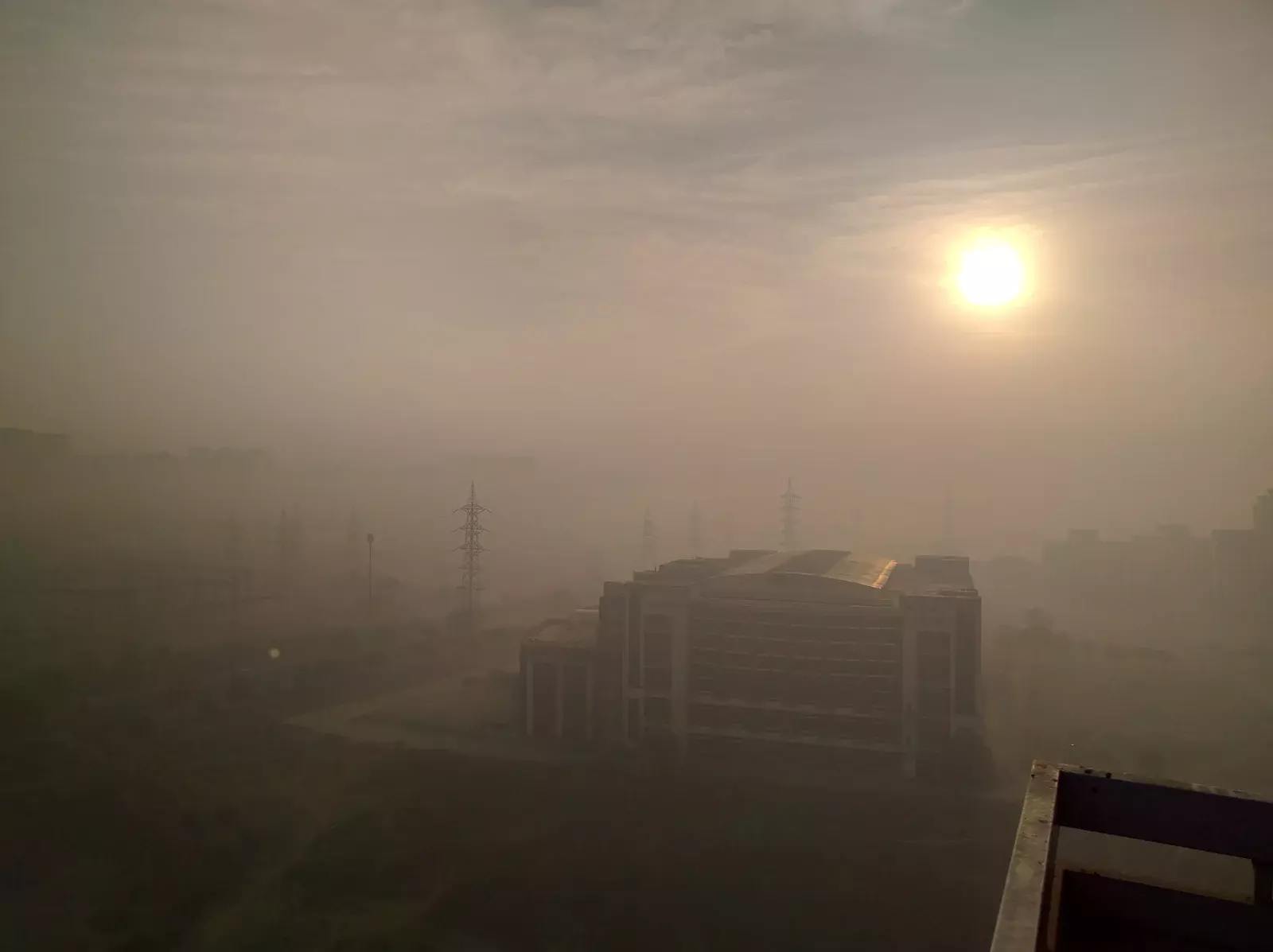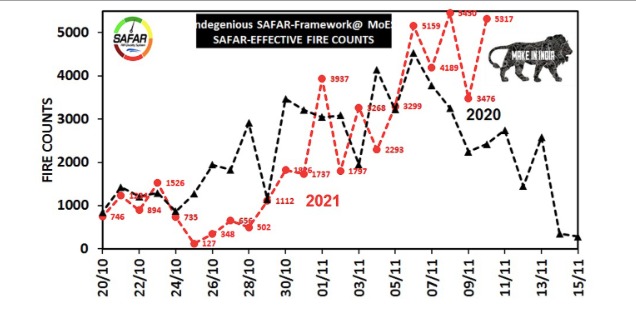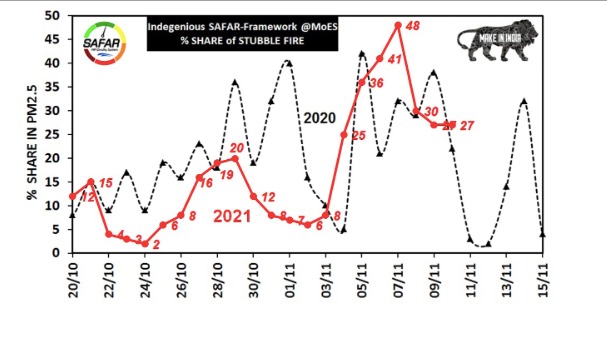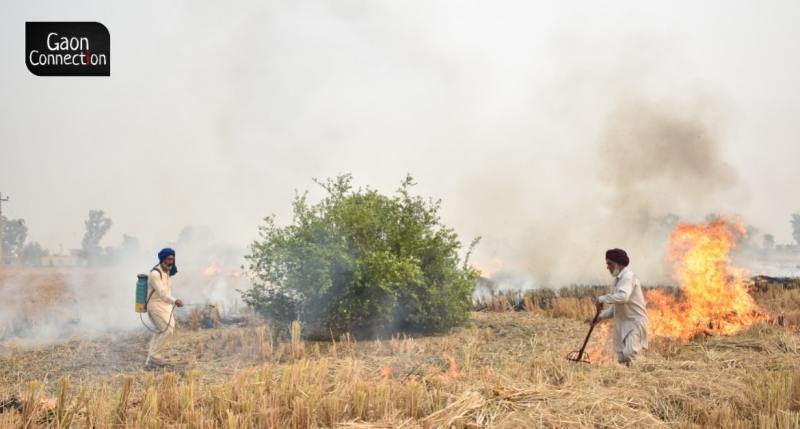Delhi’s worst Diwali night in the past 5 years, first smog episode to last for seven days: CSE
It’s been five days and NCR-Delhi is wrapped in its first episode of winter smog which is expected to last for two more days. Diwali firecrackers, unfavourable weather conditions, and farm fires have triggered the first episode. On November 7, the contribution of farm fires to Delhi’s air pollution was 48%, which has now come down to 27%. More details here.


Delhi's air in the month of November. Photo : Wiki Commons
It’s been five days and the national capital region of Delhi and the Indo-Gangetic plains continue to be enveloped in the season’s first smog episode, an air quality data assessment by the New Delhi-based Centre for Science and Environment (CSE) shows. As per the research and the advocacy group, the duration of the ongoing smog episode is expected to be longer than seven days.
While the smog episodes have become an annual ritual for this region, with stubble farming in Punjab, Haryana, and parts of Uttar Pradesh, CSE’s assessment shows the contribution of farm fires this year has been the lowest in the past four years.
Factors contributing to smog include unfavourable weather conditions, farm fires, and Diwali crackers that triggered the first episode.
As per the CSE analysis released on November 10, PM 2.5 (particulate matter) concentration on Diwali night (Nov 4-5; 8pm-8am) has been the most intense since 2017. Pollution levels on Diwali night were 4.5 times the average night-time levels recorded in the week preceding Diwali.
Also Read : La Niña, coupled with extreme cold this winter, to peak air pollution in north India, warn weather experts
This year, 26 of 38 operational monitoring stations hit the 1,000 ug/m3 (micrograms per cubic meter of air) mark. In 2020, 23 out of the 38 had hit the mark while in 2019 the number stood at 22 stations. As per the World Health Organization (WHO), the acceptable guidelines value is 10 ug/m3.
The non-profit also outlined that the nitrogen dioxide (NO2) levels were lower on Diwali night as compared to nights preceding it which indicates congestion and high traffic conditions in the city. It also reflected less traffic on Diwali night itself.
Talking about the contribution of smoke from farm stubbles, Anumita Roychowdhury, executive director, research and advocacy at CSE added that while the average daily contribution of smoke from farm stubble fires from the middle of October to November 8 this year has been the lowest in the last four years but since November 6, its contribution has peaked to reach 48 per cent on November 7.

As of today, November 11, the contribution of farm fires to Delhi’s pollution stands at 27 per cent. However, the total number of fires – 5,317 – is much higher than last year.

This analysis is based on the real time data available from the current working air quality monitoring stations in Delhi-NCR and the larger Indo-Gangetic Plain.
Also Read : Ahead of Diwali, Delhi’s air quality dips to ‘very poor’ category; likely to remain so till Nov 6
Stubble burning and pollution contribution
The contribution of smoke to Delhi’s daily PM2.5 during the middle of October to November 8 has been the lowest in the last four years – 12 per cent in contrast to 17 per cent per day in 2020, 14 per cent in 2019 and 16 per cent in 2018, CSE’s assessment notes.
Peak contribution of smoke to Delhi’s PM levels was recorded on November 7 when it hit 48 per cent, which is the second highest daily contribution percentage recorded since such estimation was started by the System of Air Quality and Weather Forecasting and Research (SAFAR), developed by Indian Institute of Tropical Meteorology, Pune, in 2018. CSE also pointed out that this unusually high percentage on November 7, 2021 didn’t spike Delhi’s PM2.5 levels.
Also Read : Severe peak in winter smog expected in Delhi, quick action required to counter this: CSE Report
In its earlier report released on October 23, CSE had predicted that smoke from stubble burning is going to be concentrated in the month of November because the delayed monsoon had prevented the farmers from burning the stubble in October.

Talking to Gaon Connection, Avikal Somvanshi, the programme manager at the Urban Data Analytic Lab at CSE had said, “Usually, the smog that occurs in the end October and the beginning of November is driven by stubble burning in Punjab and Haryana, however, the delayed monsoon this year stalled the stubble burning.”
Explaining how this will have an effect on Delhi’s smog, he added, “This implies that the stubble will be burnt in a concentrated manner, at the end of the month. The quantum of smoke coming to Delhi would be in higher concentration which will lead to a peak in smog.”
The advent of the monsoon’s retreat date almost perfectly coincided with the start of bad air days in Delhi. Bad air days means the PM2.5 average breaches the standard and remains above that for the rest of the season.
As per the Central Pollution Control Board (CPCB) air quality standard (AQI) is categorised into six parts. AQI between 0-50 is considered ‘good’, ‘51-100’ is satisfactory, 101-200 is ‘moderate’, 201-300 is ‘poor’, 301-400 is ‘very poor’, and between 401-500 is ‘severe.’

